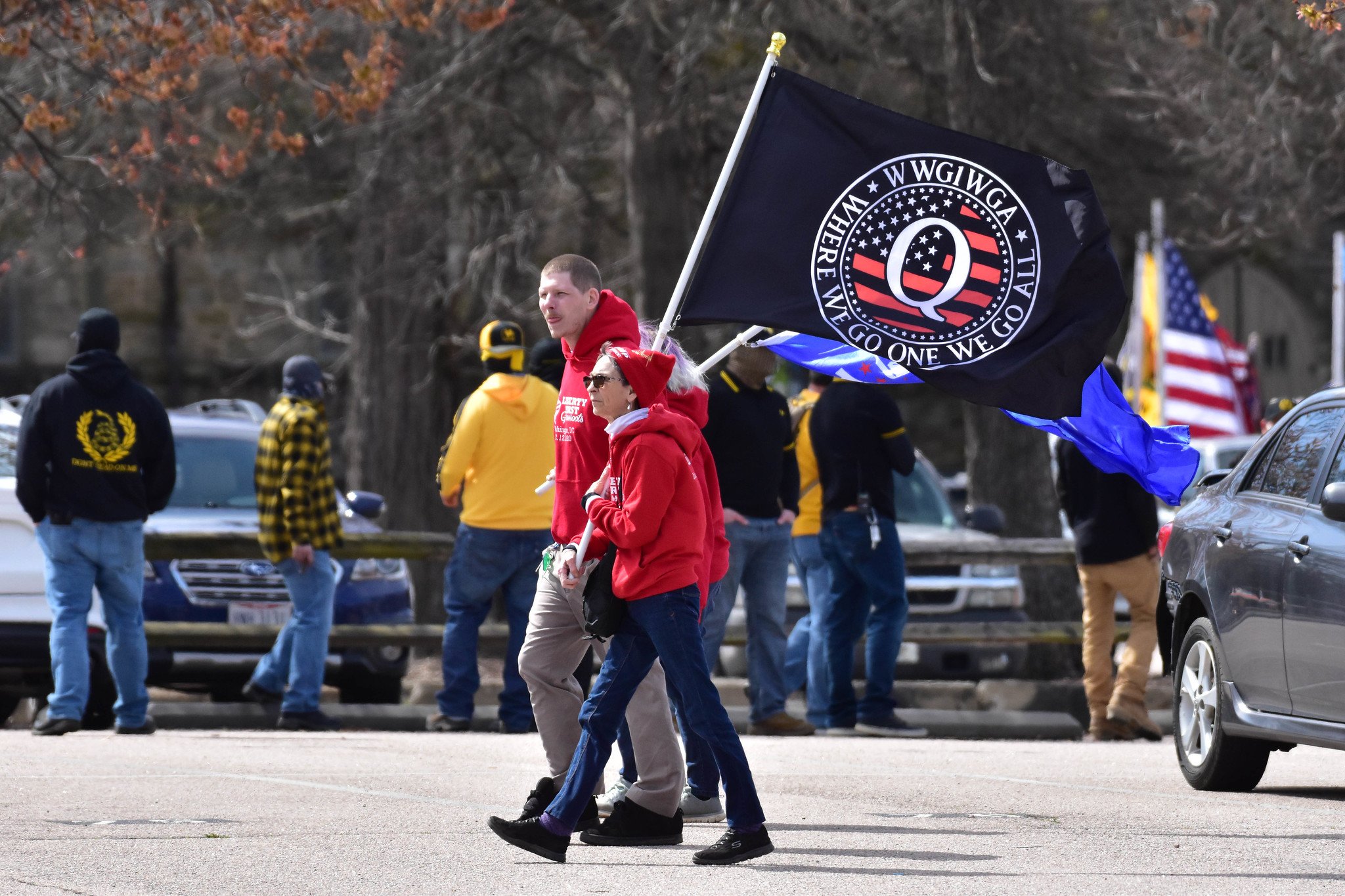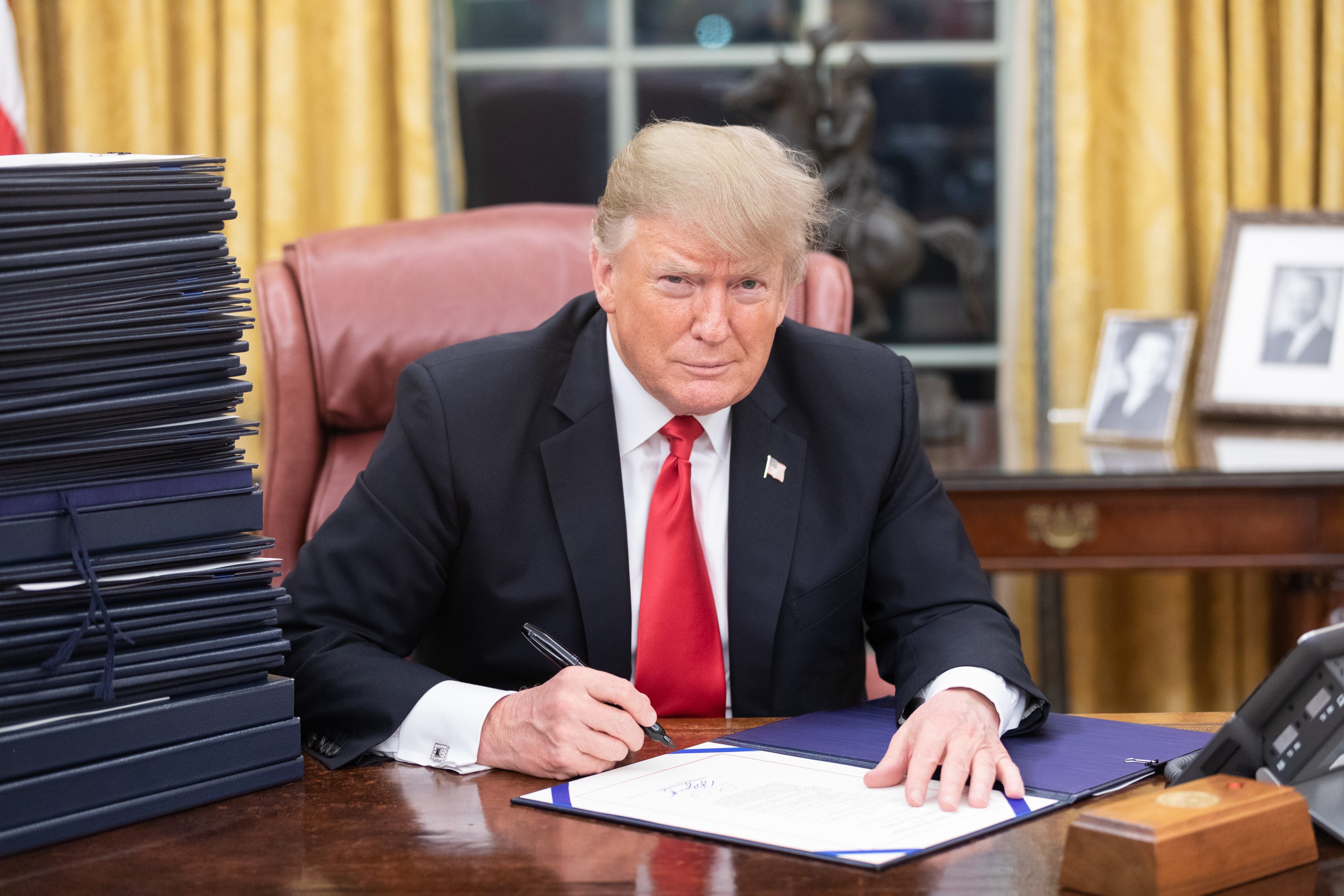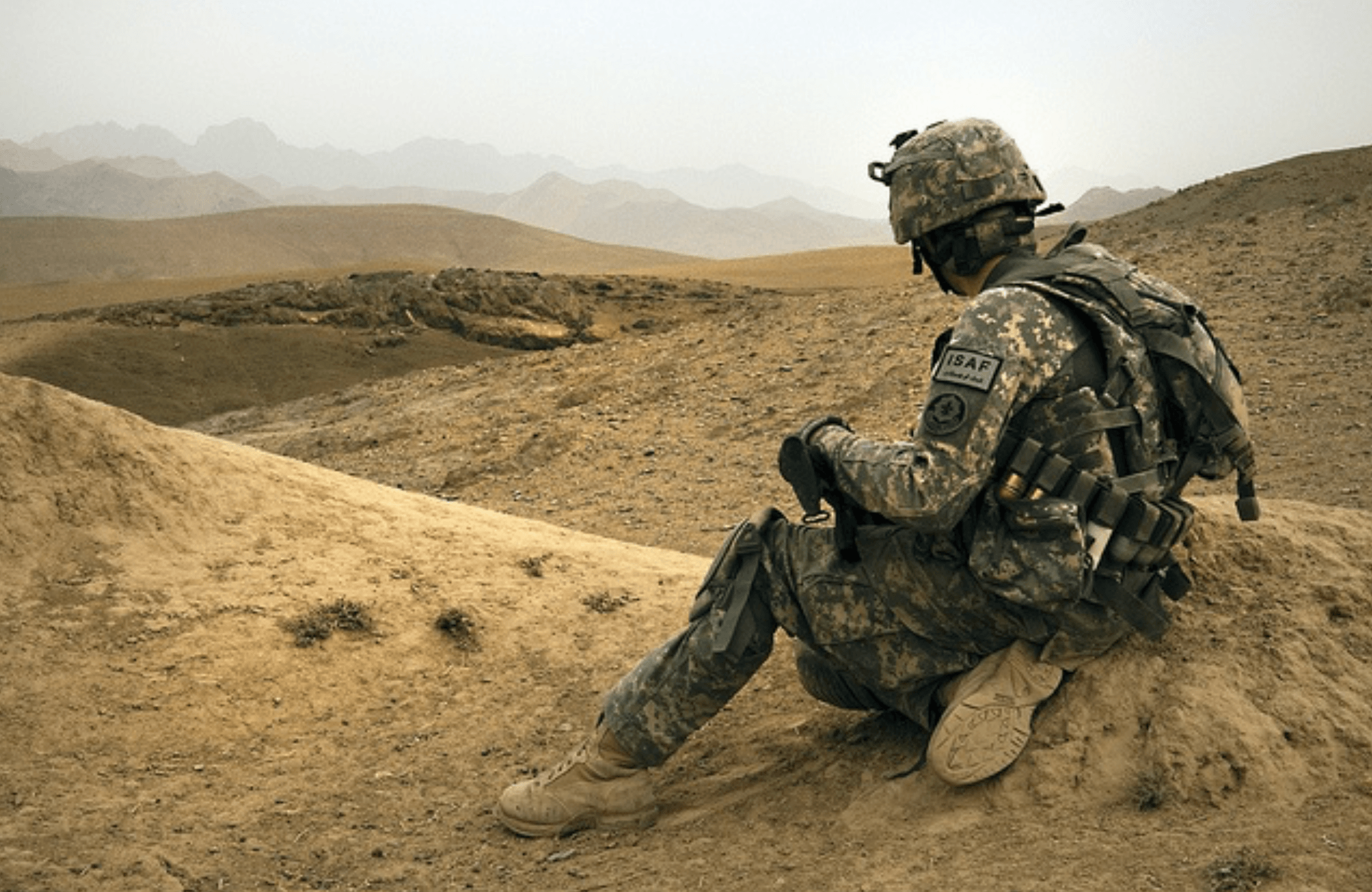What Jan. 6 Revealed About QAnon and Militias
What a study of 18 anti-government extremists arrested in connection with Jan. 6 tells us about QAnon and militia fusion.

Published by The Lawfare Institute
in Cooperation With

From flags etched with burning Qs to “Where we go one, we go all” T-shirts and the infamous “QAnon Shaman,” the presence of QAnon at the Jan. 6 Capitol attack was palpable. Also prominent, albeit somewhat less visibly, were various insignia signifying membership in far-right extremist groups like the Oath Keepers, Proud Boys, and Three Percenters.
The affiliations are distinct and without obvious overlap. QAnon adherents and these anti-government extremist groups seem entirely separate. They emerged as independent entities. People who dissected the early “Q drops” on 4chan and 8kun or who reposted QAnon conspiracy theories were not necessarily anti-government extremists, and their activities were primarily online. Oath Keepers, Proud Boys, and Three Percenters, by contrast, were defined by anti-government extremist beliefs and tended to mobilize offline in structured groups. But Jan. 6 brought many of them together. Which raises the question: Did QAnon adherents and far-right extremists turn up at the Capitol through independent motives, or did they share something in common?
The evolution and convergence of the groups’ ideologies has been a significant topic of discussion among researchers. But fewer of them have considered the question in the context of Jan. 6.
With that in mind, I conducted a study of 18 individuals arrested in connection with the Jan. 6 attack. All individuals have alleged links to both QAnon and one of three far-right extremist groups: the Oath Keepers (nine of the 18), the Proud Boys (four of the 18), or the Three Percenters (five of the 18). My review of court documents, social media posts, and reporting about their cases—as well as scholarship on extremism—revealed three shared ideological pillars: a belief in government corruption, apocalypticism, and a responsibility to defend.
QAnon
First emerging on 4chan in 2017, QAnon is an umbrella of loosely connected conspiracy theories that revolve around the central idea “that a cabal of powerful elites controls the world, using their power to covertly abuse children.” QAnon spread mainly across social media, creating communities of the conspiracy’s followers on mainstream platforms. The wide range of conspiracy theories it includes gives QAnon a broad appeal, leading to a diverse demographic of followers: women, non-Republicans, and individuals who are well educated and financially secure.
QAnon has become well known for its conspiracy theories surrounding the coronavirus pandemic and the 2020 presidential election. For instance, QAnon formed the backbone of viral conspiracy theories doubting the origin or existence of the pandemic, which helped inspire a wave of protests across the U.S. against lockdown procedures and other government mandates. Before, during, and after the 2020 election, online QAnon communities latched onto conspiracy theories of a “deep state” interfering in the 2020 election to steal Donald Trump’s election win, including the beliefs that “middle-of-the-night dumps of fake mail-in ballots [swung] red states to blue” and “Republican votes had been changed or thrown out thanks to foreign plots, complex CIA vote-harvesting programs, and the machinations of a truly evil election administrator—the voting-machine company Dominion.”
Oath Keepers, Three Percenters, Proud Boys, and the Militia Movement
The 18 arrestees I studied all have alleged ties to anti-government groups, including the Oath Keepers, the Three Percenters, or the Proud Boys. Although there is some variation in whether the groups are properly described as militias—for instance, the Proud Boys are sometimes described as “street fighters” rather than a militia—researchers have often considered them in the broader context of what’s known as the “militia movement.” Founded in Lexington, Massachusetts, in 2009 by Elmer Stewart Rhodes III, the Oath Keepers aim to recruit former military and law enforcement personnel, and they operate in local and state chapters scattered across the country. The Oath Keepers seek to uphold their interpretation of the Constitution against perceived federal tyranny. The Three Percenters are a decentralized movement founded in 2008 with multiple organizations that adhere to its ideology. Their name originates from the false historical belief that only 3 percent of American colonists fought against the British, leading to their claim that only 3 percent of Americans are needed to overthrow today’s tyrannical federal government. Finally, the Proud Boys were founded in New York City in 2016 and functioned as a street-fighting group violently opposing those they viewed as threatening the values of “Western culture,” such as Antifa, Black Lives Matter, feminists, immigrants, Muslims, and others. The Proud Boys have collaborated in the past and continue to collaborate with radical anti-government extremist groups, white nationalists, and neo-Nazis in events that frequently result in violence.
The Oath Keepers and the Three Percenters have occupied prominent places in the militia movement since their creation because of their ideologies centered around militia conspiracy theories like the New World Order. The Proud Boys, sometimes referred to as an “alt-lite” street fighting group, have recently taken a clearer place alongside the Oath Keepers and the Three Percenters in the militia movement. In the months leading up to the Capitol attack, the Proud Boys became increasingly connected with numerous militias, and their ideological similarities were on display when they collaborated with the Oath Keepers on Jan. 6.
For that reason, it is helpful to consider all three groups in the broader context of the modern militia movement in the United States, which dates back to the 1990s. The movement, composed loosely of militias and anti-government extremist groups, formed in reaction to federal gun control measures and deadly standoffs between civilians and federal agents. Groups within the movement continue to be characterized by their emphasis on paramilitary activities and belief that the U.S. government is tyrannical, collaborating with the New World Order to oppress Americans under the rule of a one-world government. The militia movement gained momentum from its inception around 1992 (corresponding with the Ruby Ridge standoff) until the late 1990s. However, after Timothy McVeigh bombed the Murrah federal building in Oklahoma City in 1995—an act that had been reportedly inspired by pro-militia literature and conspiracy theories—the movement’s activity declined significantly. Another wave of anti-government groups in the militia movement emerged after the election of President Barack Obama in 2008. Finally, the militia movement rose in a third wave after the election of President Trump. With each of these resurgences, the dominant ideology of the militia movement has shifted. Most notably, the focus pivoted away from targeting the federal government after Trump—whose candidacy the militia movement had supported—won the election. Instead, focus moved toward “other perceived enemies, such as Antifa” and opposing “state-level gun control measures, state-level pandemic-related restrictions, and Black Lives Matter protests.”
The Militia Movement Meets QAnon
Recently, dominant ideologies within the militia movement have shifted yet again, this time finding a rallying point around QAnon conspiracy theories. As early as 2019, the Southern Poverty Law Center released a report claiming that anti-government extremists “are increasingly subscribing to and propagating the QAnon conspiracy theory, which asserts that pro-Trump forces will soon take down the so-called deep state.” Throughout 2020, as members of extremist groups coalesced in what researchers have termed a “militia-sphere,” their messaging latched on to QAnon conspiracy theories.
The confluence is perhaps not surprising, as both ideologies share three common ideological foundations. The first is a deep belief in government corruption. For the militia movement, the corruption is located in the American federal government, particularly among members of the Democratic Party. Several conspiracy theories that took root decades ago serve to reinforce this belief. For example, the New World Order conspiracy theory, which originated in the 1990s, claims that a cabal of global elites has infiltrated the U.S. government and is actively working to erode American sovereignty with the goal of eventually bringing all Americans under a global government through the United Nations. The militia movement claimed that government corruption was evident from Jewish banking conspiracy theories, alleged communist infiltration into the federal government, and COVID-19 conspiracy theories.
For QAnon adherents, the corruption is also located within the American federal government, where a purported cabal of elites practicing Satan-worshiping rituals and running a child sex-trafficking ring are secretly plotting against Donald Trump. When Trump lost the 2020 presidential election, QAnon adherents extended that theory, decrying an alleged leftist conspiracy to steal the election.
Suddenly, QAnon election fraud conspiracy theories’ claims aligned quite well with the militia movement’s preexisting ideological foundation of federal government corruption. Arrestees echoed QAnon concepts of the deep state and 2020 election fraud while combining them with militia ideas like communist infiltration of the federal government, with one arrestee claiming that the “country has been SOLD to CHINA,” since “China gave us a god damn virus, they stole our elections, [and] bought our politicians.” Other arrestees interpreted QAnon 2020 election conspiracy theories as further evidence of preexisting government corruption founded in militia ideas of global government takeover, alleging that the election was stolen by a “criminal, corrupt government establishment that has been compromised by foreign nations that are under the control of global, elite technocrats.”
The second ideological pillar QAnon and the militia movement share is known as apocalypticism—the belief that the end of society as we know it is imminent. In the militia movement, this apocalyptic theme presents itself through predictions of a future conflict between members of the movement and the federal government (either a second revolutionary war or a second civil war). Militia members believe that they will triumph at the end of this conflict and have an opportunity to rebuild a utopian society from the ashes of the previous American civilization. In QAnon, apocalypticism is most evident in the prophecy of the “Storm,” a day of reckoning in which the agents of the deep state will be revealed and arrested before being shipped off to Guantanamo Bay to face military tribunals and eventual execution.
My review of the 18 Jan. 6 arrestees’ social media posts and digital communications identified apocalyptic rhetoric echoing—and even merging—both QAnon and militia movement ideologies. The arrestees imagined widespread violent conflict against the government in which “patriots” would purge the federal government of “treasonous” political leaders and reconstruct their ideal society, sparked by patriots’ intervention in the political processes of Jan. 6. All of this is consistent with the militia movement’s historical embrace of violent, revolutionary rhetoric, resting largely on the idea that the American people are headed toward an unavoidable “future conflict with the federal government.”
The third shared ideological pillar is the notion of a responsibility to defend. QAnon, in imagining nefarious actors in almost all aspects of public life, built a community of “people who are determined to think you’re in danger, and that it’s their job to protect you, while the only real danger is their protection.” Although notably applied to children, as seen in QAnon adherents’ consistent “save the children” messaging, QAnon’s responsibility to defend also included Donald Trump and his presidency following the 2020 election. QAnon conspiracy theories about the 2020 election imbued in Q’s followers that “Trump had no chance of losing as long as the election was conducted fairly and legally,” whereas a Biden victory “meant the election was stolen and illegal.” By raising the stakes of Trump’s electoral loss to the destruction of fair government, QAnon election conspiracy theories created a responsibility to defend Trump’s presidency: A Trump loss, as one arrestee stated, meant “we have zero democracy.” Likewise, many of the 18 arrestees alluded to the militia movement’s long-standing self-identification as saviors of the nation. They appeared to view themselves as “patriots” who had legitimate authority to use violence and intervene in political processes to defend the nation and Trump against the corrupt government and Antifa, who were trying to push through a “stolen” election.
Implications
These shared ideological foundations create common ground for otherwise unrelated groups, at least as they pertain to the 18 subjects of the study. The 2020 election and its aftermath revealed a bond between QAnon and the militia movement that is likely to persist because of the Biden administration’s perceived illegitimacy and threat to liberty. QAnon election fraud conspiracy theories may also draw in more extreme groups such as the “boogaloo bois," whose growing presence in the militia-sphere may represent the emergence of “a faction that is particularly receptive to opportunities to conduct violent actions under the umbrella philosophy of accelerationism.” Researchers also fear that QAnon conspiracy theories may attract individuals from the mainstream to the militia-sphere, particularly when they are banned from social media for QAnon-related posts. Such individuals are then more likely to be exploited by organizations in the militia movement and other far-right groups on alternative social media platforms.
The confluence of ideas presents opportunities for reciprocal radicalization. There is also a risk of broader ideological convergence, which “confuses counterterrorism defenses, eroding predictability and challenging law enforcement and intelligence categorizations,” making it harder for authorities to “adequately prepare countermeasures, let alone warn and defend potentially targeted communities and sites.”
Now, the 2024 presidential election is approaching, again conjuring images of Q flags waving alongside fatigues-clad extremists in stack formation. In the face of these far-right convergences, was Jan. 6 only a snapshot?


-(1).jpg?sfvrsn=b91ff6a6_7)


